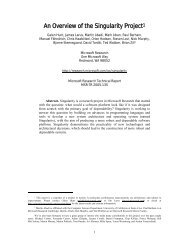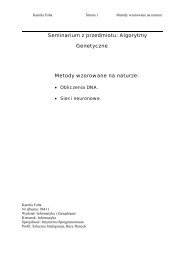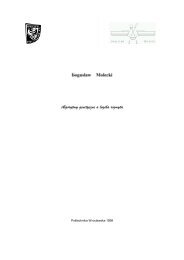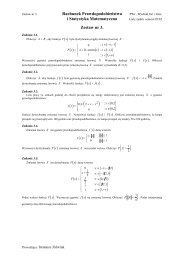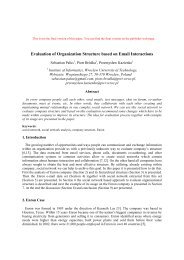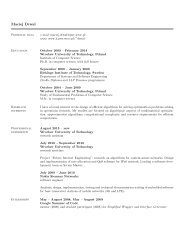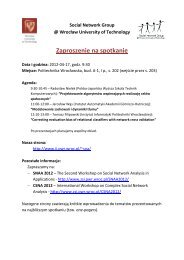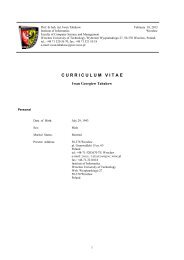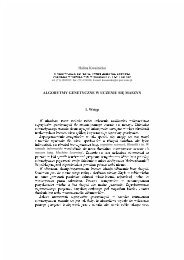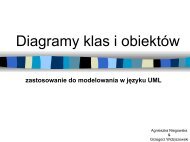Conceptual Methodology of Developing the User Interface
Conceptual Methodology of Developing the User Interface
Conceptual Methodology of Developing the User Interface
Create successful ePaper yourself
Turn your PDF publications into a flip-book with our unique Google optimized e-Paper software.
The purpose <strong>of</strong> <strong>the</strong> experiment was to carry out a project and build an applicationaccording to stages <strong>of</strong> IDI and verify <strong>the</strong> results. As a result, IDI should gives<strong>of</strong>tware with interface integrated with marketing image <strong>of</strong> <strong>the</strong> customer and UIcharacterised by high usability level.Three students <strong>of</strong> <strong>the</strong> Faculty <strong>of</strong> Computer Science and Management <strong>of</strong> WroclawUniversity <strong>of</strong> Technology took part in <strong>the</strong> experiment. The subject <strong>of</strong> experimentalproject was to build an application that will help students to sign in toobligatory and optional courses. The students created thirteen user’s stories andseven <strong>of</strong> <strong>the</strong>m were implemented in two iterations. At <strong>the</strong> end <strong>of</strong> each iteration,usability tests were performed. The tests included a list <strong>of</strong> tasks to perform anda questionnaire to fill in. The questionnaire had eight questions about visualaspect <strong>of</strong> <strong>the</strong> created UI. After two iterations, <strong>the</strong> summary test was applied inorder to evaluate <strong>the</strong> tasks, which were identified as <strong>of</strong>ten performed.The results <strong>of</strong> all tests were <strong>the</strong> basis <strong>of</strong> tentative evaluation <strong>of</strong> IDI methodology.The evaluation <strong>of</strong> <strong>the</strong> visual aspect <strong>of</strong> <strong>the</strong> interface was always between 6 and 7,in seven-point scale (1 means disappointment and 7 — full satisfaction <strong>of</strong> performinga task). 80% <strong>of</strong> all tasks included in <strong>the</strong> test were evaluated by <strong>the</strong> users as“very easy to do” and <strong>the</strong>re was no value lower <strong>the</strong>n “nei<strong>the</strong>r easy nor difficult”.It is very important that marks given in <strong>the</strong> second iteration were higher than<strong>the</strong> marks given by <strong>the</strong> users in <strong>the</strong> first one.Despite <strong>the</strong> very high evaluation <strong>of</strong> <strong>the</strong> experimental project, a tentative evaluation<strong>of</strong> methodology IDI cannot be done. The reasons for this are: <strong>the</strong> projectwas carried out by one person, <strong>the</strong> application was build by <strong>the</strong> creator <strong>of</strong> methodologyIDI, <strong>the</strong> subject <strong>of</strong> <strong>the</strong> experimental project was well known by <strong>the</strong>creator, and not all user’s stories were implemented. The evaluation <strong>of</strong> <strong>the</strong> methodologycannot by done after only one realised project. One needs to createmany applications and analyse <strong>the</strong> results, in order to be able to evaluate <strong>the</strong>methodology.5. CONCLUSIONThe goal <strong>of</strong> <strong>the</strong> work was to propose a methodology, which would fulfil <strong>the</strong> requirements<strong>of</strong> marketing trend [11, 7] and give s<strong>of</strong>tware with high usability <strong>of</strong> UI.Requirements formulated by Ridderstrale and Nordstrom impose <strong>the</strong> creation <strong>of</strong>marketing image <strong>of</strong> <strong>the</strong> company, employees and products as a whole. The way



